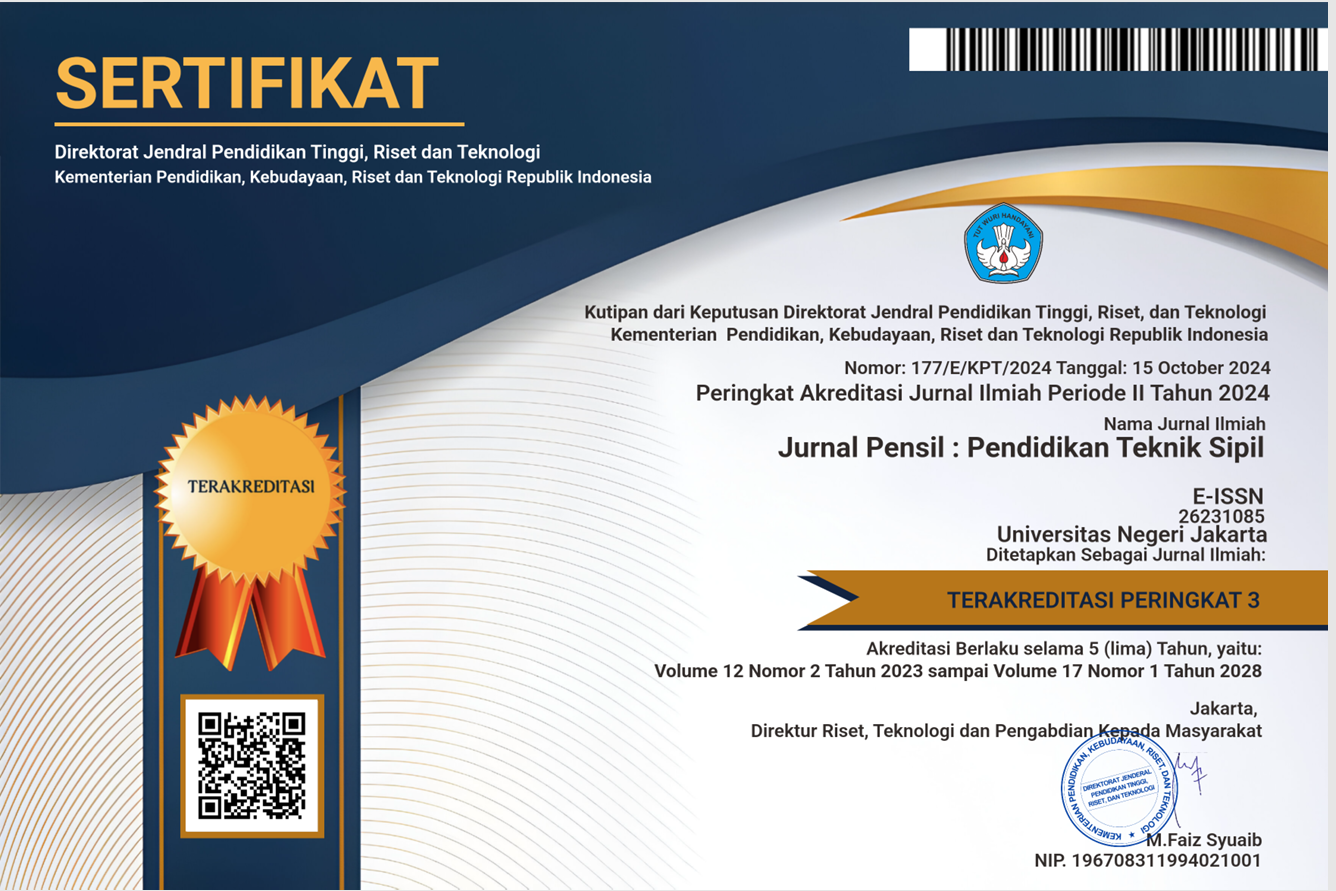COMPARATIVE STUDY OF RIGID PAVEMENT PLANNING USING BINA MARGA 2017 AND AASHTO 1993 METHODS
DOI:
https://doi.org/10.21009/jpensil.v11i1.24199Keywords:
Rigid Pavement, Bina Marga 2017 Method, AASHTO 1993 MethodAbstract
This study was conducted to determine what factors influence the differences in the results of the Bina Marga 2017 method and the AASHTO 1993 method and determine which planning results are more efficient to be applied to Letjen S. Parman Street. The research method used is a comparative method, using the existing data and the latest data from surveys. As a result of analyzing a rigid road plan with a planned age of 40 years, the Bina Marga 2017 method obtained a concrete slab with a thickness of 305 mm, and the AASHTO 1993 method obtained a concrete slab with a thickness of 280 mm. Further differences in results can be seen in the level of traffic load during the service life, the diameter of the dowels, the spacing of the tie bars, and the minimum design height of the subgrade embankment. The differences in the results of these plans are caused by two main factors, namely the factor of using the cumulative traffic growth value (R) in the Bina Marga 2017 method and the direct use of the subgrade CBR value in the AASHTO 1993 method. Based on the data that has been obtained, it is concluded that the 1993 AASHTO method provides more efficient results to be applied with considerations in terms of smaller plate dimensions and fewer connections and reinforcement requirements. Which when calculating the work cost, the AASHTO 1993 methods results give a smaller number of work volumes, so it has the possibility to provide a more economical work cost than the Bina Marga 2017 methods results.
References
Almufid, A. (2020). Perbandingan Perencanaan Tebal Perkerasan Kaku dengan Menggunakan Metode Bina Marga 04/Se/Db/2017 dan Metode AASHTO 1993. Jurnal Teknik, 9(2). https://doi.org/10.31000/jt.v9i2.3076
Attah, I. C., Agunwamba, J. C., Etim, R. K., & Ogarekpe, N. M. (2019). Modelling and predicting of CBR values of lateritic soil treated with metakaolin for road material. ARPN Journal of Engineering and Applied Science., 14(20), 3609–3618.
Bakri, M. D. (2020). Komparasi Desain Tebal Perkerasan Kaku menggunakan Manual Desain Perkerasan Jalan 2017 dan Metode AASHTO 1993. Jurnal Borneo Saintek, 3(2), 47–60.
Baladi, G. Y., Novak, E. C., & Kuo, W.-H. (1991). Pavement condition index—remaining service life. In Pavement management implementation. ASTM International.
Bausano, J., & Williams, R. C. (2009). Transitioning from AASHTO T283 to the simple performance test using moisture conditioning. Journal of Materials in Civil Engineering, 21(2), 73–82.
Bennett, A. (2004). Case study methods: Design, use, and comparative advantages. Models, Numbers, and Cases: Methods for Studying International Relations, 19–55.
Brown, S. A., Stein, S., & Warner, J. C. (2001). Urban drainage design manual: hydraulic engineering circular 22. United States. Federal Highway Administration. Office of Bridge Technology.
Collier, D. (1993). The comparative method. Political Science: The State of Discipline II, Ada W. Finifter, Ed., American Political Science Association.
Dong, Q., & Huang, B. (2015). Failure probability of resurfaced preventive maintenance treatments: Investigation into long-term pavement performance program. Transportation Research Record, 2481(1), 65–74.
Gao, Z., Lenschow, D. H., Horton, R., Zhou, M., Wang, L., & Wen, J. (2008). Comparison of two soil temperature algorithms for a bare ground site on the Loess Plateau in China. Journal of Geophysical Research: Atmospheres, 113(D18).
Gautam, P. K., Kalla, P., Jethoo, A. S., Agrawal, R., & Singh, H. (2018). Sustainable use of waste in flexible pavement: A review. Construction and Building Materials, 180, 239–253.
Jain, S., Joshi, Y. P., & Goliya, S. S. (2013). Design of rigid and flexible pavements by various methods & their cost analysis of each method. International Journal of Engineering Research and Applications, 3(5), 119–123.
Kabupaten Cirebon, P. (2009). Rencana Pembangunan Jangka Panjang Daerah (RPJPD) Kabupaten Cirebon Tahun 2005-2025.
Karim, D. F., Rubasi, D. K. A. H., & Saleh, D. A. A. (2016). The road pavement condition index (PCI) evaluation and maintenance: a case study of Yemen. Organization, Technology & Management in Construction: An International Journal, 8(1), 1446–1455.
Latifa, E. A., & Prihutomo, N. B. (2019). Analyzing deterioration on arterial roads caused by overloaded business vehicles. Journal of Physics: Conference Series, 1364(1), 12057.
Lee, B. J., & Kim, Y. Y. (2018). Durability of latex modified concrete mixed with a shrinkage reducing agent for bridge deck pavement. International Journal of Concrete Structures and Materials, 12(1), 1–9.
Marga, D. J. B. (1983). Manual Pemeliharaan Jalan No. 03/MN/B/1983. Direktorat Jenderal Bina Marga.
Maulana, D. A. (2019). Perencanaan Perkerasan Kaku dengan Metode Manual Desain Perkerasan Jalan 2017 dan Aashto 1993 di Jalan Alternatif Ajung–Rambipuji.
Mubarok, A. A., Arthur, R., & Handoyo, S. S. (2018). Pengembangan Pembelajaran E-Learning Mata Kuliah PTM/Jalan Raya Pendidikan Vokasional Konstruksi Bangunan Fakultas Teknik Universitas Negeri Jakarta. Jurnal Pensil: Pendidikan Teknik Sipil, 7(2), 87–94.
Olukanni, D. O., Adebayo, R. A., & Tenebe, I. T. (2014). Assessment of urban drainage and sanitation challenges in Nigeria. International Journal of Emerging Technology and Advanced Engineering, 4(12), 100–105.
Pais, J. C., Amorim, S. I. R., & Minhoto, M. J. C. (2013). Impact of traffic overload on road pavement performance. Journal of Transportation Engineering, 139(9), 873–879.
Pramudita, D. A. (2017). Perencanaan Tebal Perkerasan Kaku (Rigid Pavement) dengan Menggunakan Metode Bina Marga dan Rencana Anggaran Biaya pada Ruas Jalan Soekarno Hatta Balikpapan. University of Muhammadiyah Malang.
Putri, A. R., Sihombing, J., Iswandaru, Y. S., & Utama, W. (2020). Analisa Kuat Tekan Terhadap Variasi Beban Pemodelan Dinding Cantilever Menggunakan Sap 2000. Jurnal Pensil: Pendidikan Teknik Sipil, 9(2), 125–130.
Sabatini, P. J., Armour, T., Groneck, P., Keeley, J. W., & Tanyu, B. (2005). Micropile design and construction (reference manual for NHI Course 132078). United States. Department of Transportation. Federal Highway Administration.
Setyawan, A., Nainggolan, J., & Budiarto, A. (2015). Predicting the remaining service life of road using pavement condition index. Procedia Engineering, 125, 417–423.
Shah, Y. U., Jain, S. S., Tiwari, D., & Jain, M. K. (2013). Development of overall pavement condition index for urban road network. Procedia-Social and Behavioral Sciences, 104, 332–341.
Smith, B. C., & Diefenderfer, B. K. (2009). Development of truck equivalent single-axle load (ESAL) factors based on weigh-in-motion data for pavement design in Virginia. Virginia Transportation Research Council.
Sulistiyatno, A., Fajri, M. D., & Moctar, I. B. (2012). Pengaruh genangan air terhadap kerusakan jalan aspal dan perencanaan subdrain. Jurnal Teknik POMITS, 1(1).
Taunk, G. S. (1998). Rigid pavement vs. flexible pavement. Indian Highways, 26(2).
Umum, D. P. (1995). Manual Pemeliharaan Rutin untuk Jalan Nasional dan Propinsi, Jilid II: Metode Perbaikan Standart. Jakarta.
Umum, D. P. (2006). Perencanaan Sistem Drainase Jalan. Surat Keputusan Menteri Pekerjaan Umum.
Vinna, A. D., Prihutomo, N. B., & Pramono, E. (2019). Analisis Tebal Perkerasan Kaku Metode AASHTO 1993 dan Metode Bina Marga 2017 Serta Biaya Pelaksanaan (Studi Kasus Proyek Jalan Tol Cinere–Serpong Seksi 1). Prosiding Seminar Nasional Teknik Sipil, 1(1), 496–506.
Wang, H.-P., Guo, Y.-X., Wu, M.-Y., Xiang, K., & Sun, S.-R. (2021). Review on structural damage rehabilitation and performance assessment of asphalt pavements. Reviews on Advanced Materials Science, 60(1), 438–449.
Wang, Y., Wang, G., & Mastin, N. (2012). Costs and effectiveness of flexible pavement treatments: Experience and evidence. Journal of Performance of Constructed Facilities, 26(4), 516–525.
Wari, W. N., Suryani, E., Ulfiyati, Y., & Syafa’at, I. W. (2020). Aged Reduction Prediction of the Road Plan Due to Overload On the Pancer Road, Pesanggaran District, Banyuwangi. IOP Conference Series: Materials Science and Engineering, 854(1), 12014.
Yuliani, R. D., Subagyo, U., & Burhamtoro. (2020). Analisis Tebal Perkerasan Metode AASHTO (1993) dan Metode Bina Marga (2003) Studi Kasus Jalan Tol Semarang–Solo Sta 41+200–46+600. Jurnal Online SKRIPSI Manajemen Rekayasa Konstruksi Politeknik Negeri Malang, 1(2), 44–49.
Zhang, H., Keoleian, G. A., Lepech, M. D., & Kendall, A. (2010). Life-cycle optimization of pavement overlay systems. Journal of Infrastructure Systems, 16(4), 310–322.
Zohri, S., Sutrisno, W., & Priyanto, A. (2019). Analisis Tebal Perkerasan Kaku Pada Jalan Tol Pasuruan–Probolinggo Berdasarkan Metode Bina Marga (Manual Desain Perkerasan 2017) Dan AASHTO (1993). RENOVASI: Rekayasa Dan Inovasi Teknik Sipil, 4(1), 33–41.
Zumrawi, M. M. E. (2014). The impacts of poor drainage on road performance in Khartoum. Int. J. of Multidisciplinary and Scientific Emerging Research, 3(1).











.png)
.png)
1.png)

